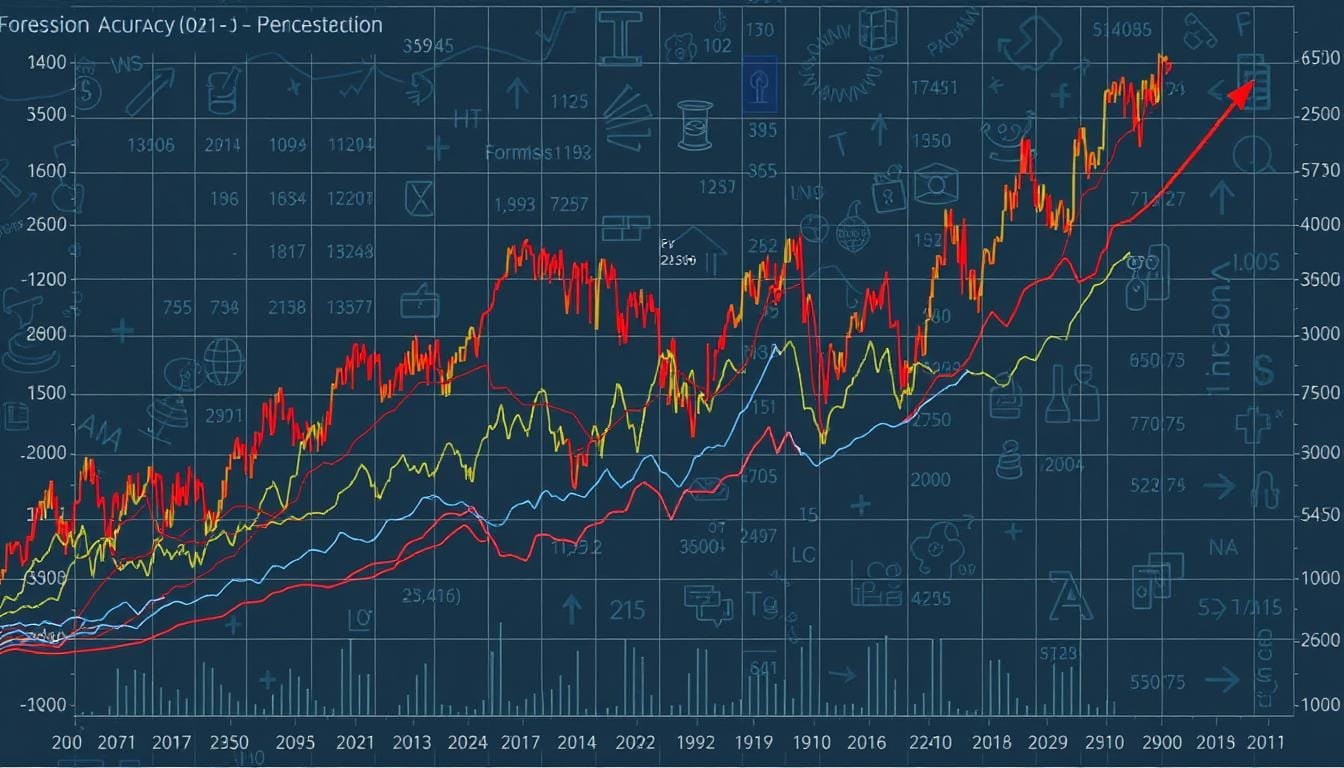We understand that economic predictions are crucial. They aren’t just about theories. Recent studies show some indicators can predict recessions a year ahead. The Confederation Board Leading Economic Index for the U.S. is very accurate. It gives us a heads-up on market trends one to three months before they happen. One key measure, the Treasury yield spread, alerts us to both good and bad economic times early, with its accuracy changing over time.
The accuracy of predicting economic slowdown fades as we look further ahead. Beyond a year, forecasts become less certain. The Federal Reserve Economic Data reflects this with an AUC value nearing 0.5. Events like the yield curve inversion since July 2022, and constant rate hikes by the Fed since March 2022, underscore our efforts. They help us decode the complex signals of upcoming economic changes.
Key Takeaways
- Indexes blending multiple macroeconomic factors indicate recessions up to a year ahead.
- The long-term Treasury yield spread is a critical predictor far before a recession or expansion.
- Near-term predictions are more accurate, reflecting a higher AUC value.
- Macroeconomic indicators’ accuracy dims significantly beyond the one-year mark.
- Amidst rising interest rates, the inversion of the yield curve holds the potential foreshadowing of an economic decline.
- The Sahm Rule and shifts in unemployment rates signal potential economic shifts.
- Goldman Sachs’ reduced recession forecast suggests nuanced economic resilience.
The Role of Economics in Forecasting Downturns
In finance and policy-making, economic forecasting plays a crucial role. It offers insights into economic trends and helps avoid crises. Yet, its ability to predict downturns and recessions is often doubted.
Historical Accuracy of Economic Predictions
The reliability of economic predictions has faced criticism, evident in various instances. Before the 2001 recession, forecasters expected a 2.5% growth in the U.S. GDP. But, growth was almost nonexistent. Similar projections were made before the Great Recession, anticipating 2.2% growth, yet the outcome was around 0.6%. These cases highlight the difficulty in making precise economic forecasts.
A detailed study, covering 153 recessions in 63 countries from 1992 to 2014, revealed a crucial fact. Most of these downturns were not foreseen by economists, pointing to a significant flaw in current recession indicators.
Differentiating Between Accuracy and Precision
It is important to distinguish between accuracy and precision in economic forecasts. Accuracy means how close the forecast is to what actually happens. Precision, however, shows how consistent forecasts are, even if they may not always be correct. The case of an inverted yield curve showcases this difference well. This recession indicator has predicted downturns 6 to 22 months in advance, showing a wide range in forecasting.
The Importance of Economic Indicators
Economic indicators, like inflation, growth rates, and unemployment, are foundational in making forecasts. These indicators refine the tools economists use. For example, shifts in GDP growth rates have served as warnings for potential downturns, though with mixed results.
Both policymakers and investors depend on these forecasts for making critical decisions. However, this reliance sometimes leads to overconfidence in their predictive power. This was clear when, despite early inverted yield curve warnings, only 2% of economists predicted a recession by July, a stark reduction from 10% in February. This shows a surprising departure from established patterns and readiness for recessions.
Understanding Recession Predictions
To understand recession chances, it’s key to know about tools like the Treasury yield curve. This tool helps experts make near-term guesses and long-term economic plans. They rely on past data for these predictions.
The Basis of Economic Forecasts
Economic forecasts help guess market trends and shape how money and investments are handled. Indicators like the Conference Board’s LEI are used. It combines important data such as the ISM Index and the S&P 500 Index.
The LEI has been a strong signal for U.S. recessions since the 1970s. It shows declines before downturns start.
Short-Term Versus Long-Term Predictions
It’s crucial to differentiate between short-term and long-term economic views. Short-term forecasts are more precise because they use current data. But long-term predictions have more uncertainty. This is because many factors can change over time.
The LEI recently showed a big drop over a year. This suggests a recession might come soon.
Having models that look at both current data and long-term trends is useful. They help make plans that can adapt to economic shifts. This can protect economies and people’s money.
The Limitations of Economic Forecasts
Economic prediction faces many challenges, especially when forecasting the future. One must look at the complexity of making long-term forecasts and the impact of market psychology. These elements blend together, creating a tough terrain for economic forecasts. This often leads to differences between what was expected and the real outcomes.
Challenges in Long-Term Economic Forecasting
Forecasting the economy for the long term is like navigating a complex maze. It’s made tougher by sudden global events and policy changes. For example, predictions by central banks such as the Bank of England and the European Central Bank were off. They forecasted a 3% inflation rate by the end of 2022, but it turned out to be around 9.2%. This had a big impact on economic plans and what the market expected.
Not just inflation, but other measures like GDP growth and unemployment have also missed the mark after big disruptions, like the Covid-19 pandemic. These times prove the need for flexible forecasting models. They show how important it is for economic strategies to adapt.
The Role of Human Behavior and Market Psychology
Human behavior and the study of behavioral economics significantly affect economic outcomes. The unpredictable nature of human psychology leads to sudden economic changes, often missed by traditional forecasts. Additionally, policies like furlough schemes during the pandemic have changed usual market and job trends, causing unexpected results.
Forecasters often fall prey to overconfidence in their models, impacting decision-making. Despite a 53% confidence in their predictions, accuracy was only about 23%. This overconfidence makes it hard to forecast the economy reliably.

To sum up, economic forecasts are valuable for planning, but they have their limits. Recognizing these limits and incorporating behavioral economic insights can make predictions more accurate and trustworthy. It’s not just about guessing future trends but also adjusting to an ever-changing economic scene influenced by many factors.
| Predicted Inflation Rate (End of 2022) | Actual Inflation Rate | Location |
|---|---|---|
| 3.4% | 9.2% | United Kingdom |
| 3.2% | 9.2% | Eurozone |
Looking into economic prediction’s challenges reveals a lot. It shows how market psychology and unexpected policy effects offer deep insights into forecasting’s tough nature. It’s not just about foreseeing trends but adapting to a constantly changing economic story, influenced by various factors of behavioral economics.
Case Studies: When Economists Got It Right (And Wrong)
In the realm of recession prediction case studies, successes and failures stand out. Economic forecast successes have won praise, but missed economic downturns reveal flaws. This mix shows how tricky predicting financial crises can be. It also shows why we must get better at forecasting.

Success Stories in Recession Prediction
Some economic forecasts have been spot on. Take the New York Fed staff in 2010. They predicted economic trends well, despite some misses in 2011. Then there’s Nouriel Roubini. He doubted the so-called Great Moderation. And he was right, identifying risks others missed.
Notable Failures and Missed Recession Calls
But there have been big mistakes in economic forecasting, too. Before the 2008 crisis, experts missed how bad the housing sector’s fall would be. This error was part of a wider issue. Experts didn’t grasp the housing boom’s flaws or how new mortgage finance worked. And during 2007-09, they thought the recession would be mild. They saw only a 5% drop. But the real fall was much steeper.
- Experts thought 2008 would see a 2.6% GDP growth. Instead, the economy shrank by 3.3%.
- The forecast unemployment rate for late 2009 was way off. It missed by 4.4 percentage points, meaning 6 million more were jobless.
- For three years, bond rate predictions were too low, showing flaws in financial market forecasting.
These stories teach us a lot. They show the gap between predictions and what really happens. This review helps us see where forecasting can improve. It’s crucial for facing future financial challenges.
How Accurate Do You Think Economics Are at Predicting Recession?
The question of economic prediction accuracy is critical in economics. It’s tough to predict recessions due to many unpredictable factors. We look at signs used to predict economic downturns.
For years, the accuracy of economic forecasts has faced real-world tests. The yield curve is a key sign for predicting recessions. It has a strong history of success. But its true test is adjusting to new economic situations and unexpected events.
We also examine the Sahm Rule, which uses unemployment rates to forecast recessions. Yet, sudden labor market changes or global shocks make this hard. These factors show the complexity of predicting downturns.
Another challenge is the probabilistic nature of economic indicators. Probit models use yield curve data to estimate recession risks. They turn data into useful insights. But they have their limits, like historical biases.

Discussing economic prediction accuracy leads to acknowledging forecasting’s uncertainties. Using various methods, the real value is in continually updating our interpretations of data.
While forecasting methods keep improving, the essence remains a mix of art and science. It involves both analyzing data and understanding the economic context. Our goal is to improve these methods for better economic insights.
Conclusion
Our study of economic signs has led us through the complex world of predicting recessions. We’ve seen how economics is key in forecasting market trends and downturns. Indicators like GDP growth, inflation rates, and labor costs provide insights. But, we need to be careful when interpreting them. The rise in GDP by 3.3% in the last part of 2023 and the jobless rate under 4% have sparked talks about economic strength.
The Federal Reserve has taken major steps, like hiking interest rates to levels not seen in 17 years. They’ve also cut down the money supply by nearly a trillion dollars. These actions often signal a coming economic slowdown. But there’s also been a 5% increase in consumer spending in 2023. Plus, households have saved a lot more, helping the economy stay afloat. So, while we have many indicators, predicting recessions precisely is still not possible.
Economic forecasting blends science with art because of its inherent limitations. Lessons from studies and past trends urge us to cautiously interpret long-term forecasts. Decision-makers, investors, and institutions will rely on skillful analysis of economic signals, informed by past data. Embracing this blend of science and art in economic forecasts helps us plan better for the future. This approach can lead to smarter decisions and greater readiness for whatever lies ahead.
FAQ
How can economics predict a market downturn?
Economics predicts market downturns by looking at indicators like inflation and unemployment. It also checks on how investors feel. But, predicting far into the future gets less accurate.
What is the historical accuracy of economic predictions in terms of recessions?
Historically, economic predictions about recessions have been hit or miss. Predictions right before a recession can be accurate. However, big recessions, like the one in 2008, were often missed ahead of time.
How important are economic indicators in predicting economic slowdown?
Economic indicators are key to foreseeing slowdowns. They tell us about the economy’s health through data like employment and consumer spending. This helps predict short-term trends and possible recessions.
What is the basis of economic forecasts?
Economic forecasts are based on current data, past trends, and indicators. They aim to predict the future economy. However, short-term forecasts are generally more reliable than long-term ones.
How does the likelihood of recession influence short-term versus long-term predictions?
The chance of recession makes short-term forecasts more accurate. They use up-to-date economic data. But, long-term predictions are less certain because they face more unknowns.
What are the main challenges in long-term economic forecasting?
Long-term forecasting struggles with complex economies, unpredictable humans, new technology, and policy shifts. Also, global events can throw forecasts off.
In what ways does human behavior and market psychology affect economic forecasts?
Human behavior and market psychology greatly impact forecasts. Choices by consumers and investors, driven by feelings and biases, make economics hard to predict.
Can you provide examples of successful recession predictions?
Successful predictions often happen just before a downturn. For example, the 1990-1991 recession was spotted early through a key indicator and slower economy.
What are some notable cases where economists failed to predict recessions?
The 2008 crisis is a big example of a missed prediction. Economists didn’t see the housing market crash coming or its global effects, leading to the Great Recession.
How do we assess the accuracy of economics in predicting recessions?
To assess accuracy, we look at how close forecasts come to real events. We check past success and distinguish between getting it right and being consistent.
